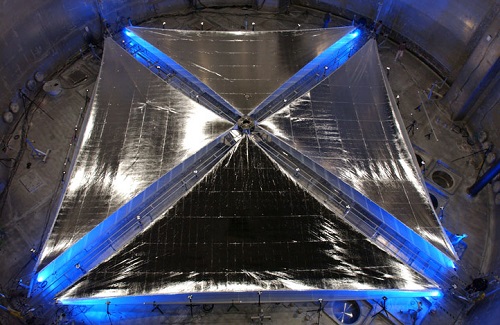Several years ago in Italy Les Johnson told me that he had once had the coolest job description in NASA. And I remember those days in the early 2000s when I was just beginning to investigate interstellar issues, and Les, working at Marshall Space Flight Center in Huntsville, carried a NASA business card describing him as ‘Manager of Interstellar Propulsion Technology Research.’ These days Les’ title is not quite as exotic but he’s involved as ever with solar sails.
Les is also an author, and among his many books is one I recommend to anyone trying to learn more about solar sails. Written with Gregory Matloff and Giovanni Vulpetti, Solar Sails: A Novel Approach to Interplanetary Travel (Copernicus, 2008) reviews the history of the concept going back to James Clerk Maxwell, who pointed out in his monumental work on electric and magnetic fields that photons can impart force to an object they encounter. Konstantin Tsiolkovsky and the Latvian scientist Friderikh Arturovich Tsander went on in the early 20th Century to describe huge mirrors made of thin materials that used photons for propulsion.
Johnson pointed out to the audience at Starship Congress in Dallas that the effect of photons on spacecraft was readily apparent as early as 1960, when NASA launched ECHO 1, a communications satellite that was essentially a giant metal balloon off which signals could be bounced. A large reflective object like this responds to the momentum being exerted upon it by photons, an effect that could now be observed in space. But a lot of people aren’t aware of what Les went on to describe, the use of photon-imparted momentum to save Mariner 10.
Launched in 1973, the craft used a gravity assist around Venus to put it on a trajectory to study Mercury, entering a solar orbit that would allow several close passes by the planet. Flaking paint from Mariner 10’s high-gain antenna confused its navigation sensors, ultimately causing the spacecraft to roll, activating its gyroscopes and venting critical attitude control gas into space. The guidance and control team at JPL was able to solve the problem by tilting Mariner’s solar panels, allowing photon pressure to create enough torque to counter the aberrant motion.

Image: Les Johnson in a NASA photo. My inexpert camera work didn’t produce a good image during Les’ talk in Dallas, so I rely on Google’s image database.
Sunjammer and Its Contemporaries
The point could not be clearer: We know a lot about the physics here, and with solar sails, even though we have only two thus far successfully launched, we’re dealing with principles that have been understood for a long time. There was serious talk about a solar sail mission to Halley’s Comet in the 1980s, with a team at JPL developing several sail designs, among them a heliogyro with multiple blades and a sail that reached 640,000 square meters, a half mile to the side. The comet mission would have jump-started the sail business but NASA rejected the proposal as too risky. Lou Friedman, former director of the Planetary Society, has written about all this in another book you’ll want on your shelf. It’s Starsailing: Solar Sails and Interstellar Travel (John Wiley & Sons, 1988), a bit hard to find these days but well worth the effort.
I had heard about the Japanese IKAROS sail before it launched in 2010 but the reality of it didn’t really sink in until I watched the actual launch. I had a window up on my computer when my wife walked by and asked what I was looking at. “The Japanese are launching a solar sail,” I said, preoccupied as the countdown continued. She walked on out of the room and then came right back. “They’re launching what?!” She knew all about solar sails (the consequence of living with me), but she was startled that after all the NASA work, along with serious studies by DLR in Germany and the Russian Progress mirrors, it was Japan that actually took a sail into space.
Johnson told me after his talk that IKAROS had truly galvanized the sail community. NanoSail-D, launched late in 2010, came next, a three-unit CubeSat that had been built as a spare for an original sail that was lost in a 2008 launch attempt. I still remember Greg Matloff calling me up after the first launch failure to tell me there was a second NanoSail, and I told him he reminded me of S. R. Hadden, the billionaire in the film Contact who tells Ellie Arroway that there is a second stargate machine after the first one is destroyed. “Why build one when you can build two for twice the price?” says Hadden, memorably played by John Hurt.
The second NanoSail-D did the trick, deploying a 10 square meter sail after a rather dramatic delay. The sail spent 240 days in orbit before re-entering the atmosphere. Now, of course, we have Sunjammer to look forward to, a major step up from NanoSail-D. NASA is saying that Sunjammer will produce a maximum thrust of approximately 0.01 newton, the rough equivalent of the weight of one of those packets of artificial sweetener you see on cafe tables. That level of thrust makes the point that sails operate slowly but surely, with a constant acceleration that, over time, achieves velocities fully compatible with exploring the inner Solar System.

Image: NASA engineers look at a 20-meter solar sail and boom system, developed by L’Garde Inc. of Tustin, Calif., after it is fully deployed during testing at NASA Glenn Research Center’s Plum Brook facility in Sandusky, Ohio. Red and blue lights help illuminate the four triangular sail quadrants as they lie outstretched in Plum Brook’s Space Power Facility — the world’s largest space environment simulation chamber. The sail material is supported by a series of inflatable booms that become rigid in the space environment. Credit: NASA/MSFC.
A Clear Roadmap for Sails
For interstellar purposes, of course, we want to do more than move supplies around the Solar System, and that is why Robert Forward started thinking in the early 1960s about pushing a huge solar sail with lasers. We might call this a ‘beamed sail’ or perhaps a ‘lightsail,’ though I like ‘beamed sail’ better because microwaves may be an even better way to push a sail and ‘lightsail’ implies lasers. In any case, the beaming idea is what counts, and Forward was soon joined by George Marx in exploring the idea. Marx wrote up a laser-driven sail concept in Nature in 1966, and we’ve been taking it apart and putting it back together ever since.
The path of sail development, though, is clear, as Johnson explained to the Starship Congress audience. You get to beamed sailcraft by first developing expertise with conventional solar sails. When the Planetary Society was attempting to launch its Cosmos sail in 2005, the plan had been to deploy and test the first operational sail, and as a part of that process a beamed microwave experiment was planned using the Deep Space Network’s Goldstone facilities. We would have learned much about the forces on the sail and how to maneuver it using both solar photons and microwaves if the craft had not been destroyed in a failed launch attempt.
We must hope Sunjammer has a better fate in its 2014 launch. Johnson said the design uses inflatable booms that are malleable and thus deployable, after which they become rigidized by the cold. The plan is to demonstrate attitude control and test the stability of the craft while performing maneuvers and moving close to the L1 Lagrange point to make scientific observations for NOAA (National Oceanic and Atmospheric Administration), which is one of the sponsors of the flight. There’s already a NOAA satellite at L1 that allows a ten to fifteen minute warning of solar storms. The beautiful thing about a sail is that it can move closer to the Sun than L1 and essentially ‘hover’ there, doubling the warning time for potential flare-induced power outages.
Of course, there are many things you can do with a solar sail, and Johnson’s comments ran the gamut. A geosynchronous satellite circling the Earth above the equator is able to stay over the same location on Earth, but you can’t accomplish that trick if you want to hover over the poles for scientific studies. Not unless you use a sail in a ‘polesitter’ orbit that relies on photon pressure to maintain its position. Robert Forward took out a patent on this concept, which he called a ‘statite,’ meaning a spacecraft that, although not orbiting, essentially hovers in place.
Forward wrote the concept up in a 1990 article for Analog and later in a story he called “Race to the Pole.” He describes how the sail would be positioned over the polar regions:
“.. . with the sail tilted so the light pressure from the sunlight reflecting off the lightsail is exactly equal and opposite to the gravity pull of the Earth. With the gravity pull nullified, the spacecraft will just hover over the polar region, while the Earth spins around underneath it.”
You can see what’s happening here: You’re balancing the Earth’s gravity and that of the Sun along with the centrifugal force of the Earth’s orbit around the Sun. A polesitter like this would be stable at about 250 Earth radii, a lot farther out than most communications satellites (about 6 Earth radii), but while this would be problematic for voice communications, it would be no problem for broadcasts into polar regions, and would allow useful meteorological studies.

Image: Dallas as viewed from my hotel room after the first day of Starship Congress.
I’ve hardly exhausted the sail mission concepts that have been studied, so we’ll continue in the same vein tomorrow. From a longer-term perspective, though, I want to emphasize that sails are a technology that can pay off at every level of development. As we look at practical uses for these craft in the near future, we can also contemplate developing them as interplanetary vehicles, perhaps as carriers of supplies to bases on Mars or the asteroids. And we can begin testing how sails behave under beamed power, knowing that building this expertise may one day lead us to space-based beamers that can drive a sailcraft out of our Solar System on an interstellar trajectory.



…sails are a technology that can pay off at every level of development…
Which is very important in terms of development. Similarly, so are beamers (I liked Lubin’s talk). Thus we have a viable technology development path where technology can be development for a variety of economic uses. There is no need to be concerned about how to build a starship – a one off project – but instead we have technologies that evolve in capability sustained by a growing economy based on them. When the time comes to build star probes and even possibly crewed ships, we will have the technology and size of economy to support it.
A beamed sail mission to near-interstellar space would be interesting, say with an instrument package like that proposed for the Innovative Interstellar Explorer. Hope it can happen in the next 30 years so I may still be around to see it!